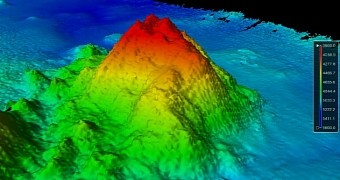While busy studying the bottom of the Pacific Ocean with the help of sonar technology, researchers came across a cone-like formation measuring about 0.7 miles (roughly 1.1 kilometers) in height.
This peculiar formation, located at a depth of approximately 3.2 miles (some 5.1 kilometers), was eventually revealed to be an underwater volcano.
According to researcher James Gardner with the University of New Hampshire in the US, this underwater volcano poses no threat to marine ecosystems or people. This is because it is extinct.
Besides, it sits far enough below the surface for vessels not to have to worry about accidentally bumping into it, James Gardner goes on to explain.
The extinct underwater volcano, located in the South Pacific Ocean at a distance of about 186 miles (300 miles) southeast of Jarvis Island, was discovered only a few weeks ago, on August 13, Live Science informs.
Researchers have yet to study it in detail, but data obtained thus far indicates that it is about 100 million years old. Since it is located at a considerable depth, specialists doubt that it accommodates for impressive biodiversity.
“These seamounts are very common, but we don't know about them, because most of the places that we go out and map have never been mapped before,” James Gardner offered as an explanation for why it took researchers this long to document this volcano's existence.

 14 DAY TRIAL //
14 DAY TRIAL //